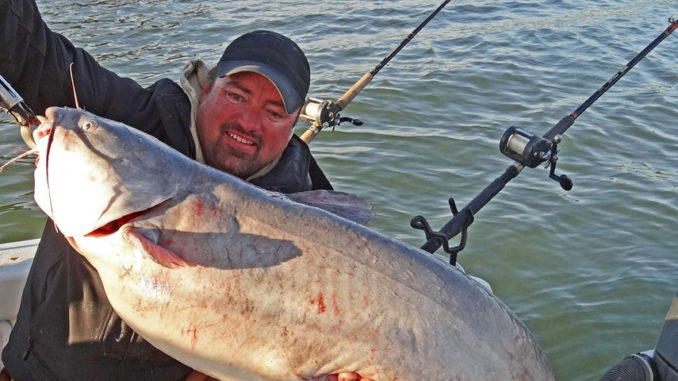
Drifting or anchoring, trophy blue catfish are there for the taking at Lake Monticello through the cold months.
Of the major catfish species in South Carolina the blue catfish seems to be the one that really chows down during the winter. Giant blues typically do that at Lake Monticello from November right on through the cold months.
Guide Chris Simpson of Greenwood recognizes the annual feeding frenzy and concentrates his efforts on the 6,700-acre lake in Fairfield County, whereas he normally splits time on Monticello, Lake Greenwood and Lake Murray.
“I go where the cats are biting, and at this time of the year, the big blue bite is excellent at Lake Monticello, a deep, clear-water lake,” said Simpson said. “The big-fish bite is great during November and though most of the winter. The largest we have landed at Lake Monticello is an 82-pounder, but I guarantee there are fish much larger than that swimming in Lake Monticello. I strongly believe there are triple-digit fish in this lake. The day we caught and released the 82-pounder, we boated seven more weighing more than 20 pounds each. That was in early December 2013. We were drift-fishing just like we do during a lot of November.
“Fishing for really big blue catfish is not a numbers game at Lake Monticello, but a typical day at this time of the year would entail catching maybe 10 or more, with the average size being 15 to 25 pounds,” said Simpson (864-992-2352). “That’s just the average-size fish. We’re catching a lot of catfish in excess of 30 pounds and quite a few 40 pounds and larger. One day we boated a 52- and a 60-pound blue catfish. That’s outstanding big-catfish action anywhere, anytime.”
Simpson said both drift-fishing and anchoring will work well during the fall and winter, with the key component being to fish in 50 to 70 feet of water on most days — sometimes deeper as the water cools.
“The weather will change my approach in terms of whether I fish deeper or shallower,” he said. “I’ll fish toward the shallow range on cloudy days or deeper during clear, post-frontal conditions. Best baits seem to have a daily pattern as well, and I use both gizzard shad and white perch primarily, but I offer catfish a lot of choices in terms bait size and variety.
“On some days, a big gizzard shad head will produce big fish bites, while on another day, the bite will come on a small chunk of cut white perch or shad,” he said. “A daily pattern develops, so I’ll adapt and usually start each trip using a variety of small and larger baits, including a few big slabs of bait. Once I get a pattern for the day, I focus on that.”
Simpson said he primarily fishes points, humps and saddles.
“Big blues will orient to these types of areas more than anything else,” he said. “When drift-fishing I use the standard drift rig with an 8/0 hook, but because of the depth, I am using up to 2 ounces of weight. For anchor-fishing I’m using a basic Carolina catfish rig with up to 3 ounces of weight, plus sometimes, I’ll use the drift rig as well on an anchor set-up, but cast to a stationary position. The float on the drift rig causes the bait to be just off the bottom, and sometimes that small thing will make a huge difference. Some days both rigs work, but often they prefer one over the other when anchored.”
Simpson said before anchoring, he likes to find a lot of catfish marked on his graph, along with a lot of bait in an area. That has the potential for a good anchor bite. He uses Shakespeare’s 7- and 8-foot medium-heavy rods with baitcasting reels spooled with 25-pound test line, with 50-pound leaders tied to an 8/0 Gamakatsu circle hook.
William Attaway of Pomaria is another Lake Monticello guide. A 39-year-old former logger who now works in the fuel delivery business in Newberry, he has fished Monticello since he was 15 and has guided for four years, primarily on weekends.
“During November and December, I generally drift-fish, and I occasionally do some things different than most fishermen,” he said. “I generally drift-fish the bottom. Based on what I see on the graph, I sometimes fish for suspended fish — a great summer pattern for blue and channel catfish at Lake Monticello. I’ll use free lines, lines rigged with split shot to go a bit deeper and down rods with heavy weights set to the depth I mark the suspended fish to target them. But typically at Lake Monticello, as the weather gets colder, this suspended pattern occurs less often. But I watch for the right conditions, especially early in November, because when they suspend, it can quickly add fish to the cooler.”
Attaway said time of day is not a real factor in success since most of the fish are deep, but he typically gets on the lake early.
“Time of day seems to have little relevance in terms of planning a trip,” Attaway said. “I’ll usually start, early but the best bite can be early, mid-day or mid-afternoon. But the quality of fish we’re catching makes it worth the wait if they don’t bite early.
“I think a big factor in when the fish bite the best is when they are pumping water either in or out of the lake, because that creates current or moving water, and that seems to trigger the fish to bite,” he said. “We’ll catch fish without moving water, but the moving water can really turn big blues on and I don’t want to miss that, especially if it only lasts a couple hours, so going early is important from that standpoint.”
Attaway (803-924-0857) said threadfin shad, gizzard shad, bream, perch and chunks of chicken breast are among his favorite baits.
“The catfish here do feed on mussels at certain times of the year, so a chunk of chicken breast, without any extra attractant, is often very appealing to these catfish,” Attaway said. “I typically use a 5/0 circle hook and an 18-inch leader with 50-pound test line.”
Attaway said that using a graph on Lake Monticello can be very important and key to consistent success.
“The lake is deep and clear, and most of the fishing is deep on specific targets — even if you’re drift-fishing,” he said “Plus, there are areas of standing timber that you need to avoid in terms of drift fishing. Most of the lake is clean from 60 feet and shallower, and in some cases, there’s no timber even deeper. I mark the timbered areas on my graph.
“I also have the ability to track where I drift, and if I get on a real productive drift, I can repeat it almost exactly, and that can be very important if the fish are on the top of humps or just off to the side of a ledge. Sometimes, a long drift over a series of humps and valleys will be the best bet.
“I look for fish and forage in close proximity scattered on my underwater targets when I drift, and I also look for how the fish are positioned in relation to the bottom and the forage. If they are holding just off the bottom, near bait, rather than hugging the bottom, they are more likely to be biting, active fish based on my experience.”
Simpson said one of the best things about fishing in November and December is that you can catch big fish drifting for fishing on anchor. As the water continues to get colder, he said the drift-fishing bite will slow down for him.
“The basic pattern for drift fishing is to use my graph and look for a good combination of big fish, along with forage fish, scattered in a definable area,” Simpson said. “Those two, catfish and forage, go together, especially for big blue catfish. I usually drift in the main-lake portion, but I will focus my efforts on the humps, points and ledges, and the 40- to 70-foot depths are a good range to begin. As with everything at Lake Monticello, it is subject to change. For larger fish, I have found that drifting slow is better, usually less than 0.5 miles per hour.”
Simpson said that Monticello is loaded with blue catfish of all sizes.
“It comes down to what you want to target on any given day,” he said. “Another key element that William and I agree on is the use of the graph. Monticello is a wide, open body of water, but is loaded with underwater humps, points that drop into deep water, saddles or deep holes between humps and just deep holes. The key is to use quality electronics to help find, interpret and pinpoint the areas the catfish are using and the depth they are found. Once you have that information, you can make proper decisions about … drifting or anchoring that day. More than most lakes, Monticello is a lake that catfish anglers need to heavily rely on their electronics and spend a reasonable amount of time searching so they can have an effective game plan and adjust fishing techniques accordingly.”
Simpson’s bait will vary with what he or his party wants to target. During fall and winter, a big gizzard shad, anywhere from eight to 12 inches long, is a great bet for big fish when cut into big chunks. He usually cuts one into three parts: head, middle and tail sections. He’ll also fish fillets cut from the side of the shad, leaving some bones in for best results. He’ll also use white perch, with the head section a favorite of his for big blues. For numbers of fish, he’ll simply use smaller baits but those often will catch big fish as well.
“One of the main reasons I love to fish Monticello during this time of the year is that it’s ripe for catching big blue catfish,” he said. “We do catch some smaller channel catfish as well as plenty of teeners: blue catfish in the 10- to 20-pound class. But it is that 30-pound and often much larger catfish I hope to hook. If targeting a massive blue catfish, it’s hard to beat Lake Monticello at this time of the year.”
DESTINATION INFORMATION
HOW TO GET THERE — Lake Monticello is in Fairfield County, north of Jenkinsville and west of Winnsboro. It lies between I-26 and I-77 and can be accessed from SC 34 between I-26 and Winnsboro, turning south at Salem Crossroads off SC 34 onto SC 215. The lake has two public boat ramps, one just south of the SC 99 bridge on the lake’s upper end, and just north of Lake Monticello Park off SC 215 on the lake’s southeastern side.
WHEN TO GO — Fishing for big catfish is good throughout the year, but guides pick the cold weather months as the best time to target the really huge catfish. November and December rank as among the top times, but even January and February can produce excellent big-fish action.
TECHNIQUES/TACKLE — Most guides strongly recommend heavy baitcasting or spinning tackle because of the potential for huge fish. Line of 50-pound test or even greater, especially for leaders, is typically used. When drifting, a Santee-style drift rig with a “slinky” weight above the leader and a small float threaded on 8 to 10 inches above the 8/0 circle hook is best. For anchoring, a Carolina rig with a 2- or 3-ounce sinker placed above the swivel, with an identical leader situation tied to the other end of the swivel is ideal. Some guides use a mixture of leaders with no floats on some rigs and use of 2-inch floats on others simply to have a different presentation for picky catfish.
FISHING INFO/GUIDES — Chris Simpson, Fighting da Blues Guide Service, 864-992-2352, www.fightindablues.com; William Attaway, Slick Willies Guide Service, 803-924-0857.
ACCOMMODATIONS — Fairfield County Chamber of Commerce, 803-645-4242, www.FairfieldChamber.sc; South Carolina Association of Visitor Bureaus, www.discoversouthcarolina.com.
MAPS — Delorme South Carolina Atlas and Gazetteer, 800-581-5105, www.delorme.com; Fishing Hotspots, 800- ALLMAPS, www.fishinghotspots.com; Kingfisher Maps, 800-326-0257, www.kfmaps.com.

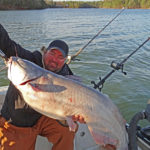
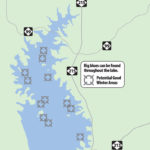
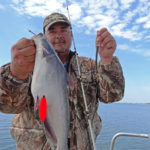
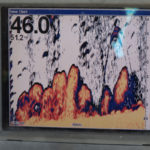

Be the first to comment